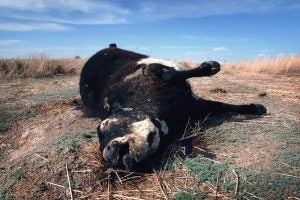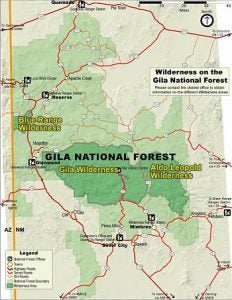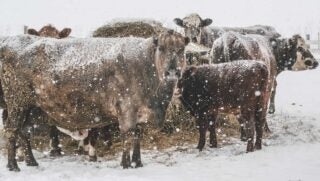Gila National Forest officials completed their aerial slaughter operation in the Gila Wilderness on Tuesday using lethal methods after a temporary restraining order was denied by plaintiffs against the U.S. Forest Service.
And, although 150 head of cattle were purported to be causing a significant threat to public safety and natural resources in this area of New Mexico, USFS managed to dispatch just 19 head — a far cry from their initial “aim” of close to 150.
During the three-day operation, a contracted Animal and Plant Health Inspection Service wildlife shooter covered the project area with the naked eye and thermal imagery by helicopter. Gila National Forest Supervisor Camille Howes said in a news release that, “We are committed to removing these feral cattle as safely, efficiently, and humanely as possible to ensure a Gila Wilderness that is safe and resilient for generations to come.”
She also expressed the Forest Service’s commitment to working collaboratively with the ranching community, saying the Gila National Forest “will continue to coordinate with permittees in their efforts to locate, gather, and remove their branded cattle from areas where they are not authorized.”
The New Mexico Cattle Growers’ Association disagrees with Howes. After meeting with the USFS for over a year, on a monthly basis to offer solutions that avoided lethal aerial slaughter, NMCGA said that the USFS was not interested in any common sense approaches.
All of the dispatched cattle were left on site to decompose. And, although carcasses were not shot (this time) adjacent to or in any waterbody or spring, hiking trail, or culturally sensitive area, the waste of life and beef has caused frustration and outcry among producers, activists, Gov. Lujan Grisham, and much of the public.

“What a waste of taxpayers’ money,” said Loren Patterson, NMCGA’s president. “Reporting 19 head killed over several days of flight just shows that the United States Forest Service has absolutely no idea about the actual herd numbers in the Wilderness and has no evidence to support its claims that a herd of 150 head was causing dire terror and environmental damage. The environmental organization the USFS apparently listens to has failed it.”
Solutions that NMCGA offered included a request to give a recent New Mexico Livestock Board directive a year to show whether it would be effective. The directive would authorize any valid allotment owner within the Gila National Forest and the Gila Wilderness to gather unbranded cattle, hold them for proper inspection and purchase them from the NMLB.
Another proposal was to ask the USFS to allocate funds to repair existing infrastructure in the Wilderness to facilitate the humane gathering of the cattle. Those facilities would aid in holding captured cattle and serve a useful purpose for using bait traps with salt blocks, water, or feed.
According to NMCGA, in the 1990s, an active grazing allotment included infrastructure to gather estray cattle. The Forest Service bulldozed that infrastructure — creating a monumental task to remove cattle by traditional means. Last year, fires also burned down hundreds of miles of fences, meaning cattle gunning is only a temporary matter of population control. The association argues that the solution is a simple fix, and infrastructure still needs to be created and repaired to avoid the issue of feral cattle in the wilderness in the future.
“Traditional methods in the hands of skilled cattlemen have proved useful in reducing the number of estray cattle across New Mexico,” said Patterson. “Unless the Forest Service takes an internal look at their lack of infrastructure and is willing to turn to long-term tried and true solutions, estray cattle will move back into the area, and these expensive aerial gunning operations will have accomplished nothing.”
“There’s a severe danger here, not just in this particular case and the horrific results that it will actually bare if this is allowed to go forward. But it also has long-term ramifications for the power of federal agencies to disregard their regulations that they themselves passed,” Daniel McGuire, an attorney for the NMCGA and other plaintiffs, told the U.S. District Judge Browning last week.
»Related: Forest Service clamps down on N.M. family’s herd, sparking pro-ranching rally
Just one year after cattle were gunned down in New Mexico’s Gila Wilderness, ranchers have received an impound notice from the U.S. Forest Service, potentially setting the stage for more aerial cattle shooting.
Allotment owners near the Gila Wilderness received a Notice of Intent to Impound Unauthorized Livestock on Feb. 1. The impound notice indicates that unauthorized livestock may be impounded as soon as this week.
Just two weeks notice to remove estray livestock out of a 559,688 acre rugged wilderness area in the middle of winter in an area only accessible on foot or by horseback.

Ranchers whose cattle are impounded will be given the opportunity to regain possession of their cattle, but only after they’ve reimbursed the Forest Service for the cost of impound, feed, and care of livestock up to or equal to the animal’s fair market value. Producers will have 5 days after printed notice of livestock impounding to redeem their cattle — those not claimed will be sold at a public sale, condemned, destroyed, or otherwise disposed of.
But, most of these cattle aren’t likely owned by surrounding ranches. The New Mexico Cattle Growers’ Association writes, “Since the grazing allotments in the Wilderness are vacant, the ranchers bordering the area have solely carried the load of infrastructure repairs and responsibility thrust on them by a negligent agency.” But, the association argues that gunning cattle down and leaving their carcasses to rot isn’t the solution.
Estray, feral, and maverick (or unbranded) cattle have inhabited the Gila Wilderness — one of the oldest wilderness areas in the country — since the 1970s. According to reports, the U.S. Forest Service began its efforts to remove cattle in the 1990s. Since then, over 700 cattle have been removed from the area, but the U.S. Forest Service estimates that there are still up to 150 cattle remaining in the wilderness area.
Last February, aerial gunning operations resulted in the shooting and killing of 65 head of cattle. The decision to gun down estray cattle came on the heels of a Center for Biological Diversity lawsuit to damages to riparian areas.
The New Mexico Cattle Growers’ Association says that they fear the notice is, “Unquestionably a step toward another aerial gunning mission.” Association’s leadership and other industry stakeholders have been trying to encourage the use of water and feed traps using pens, fencing, and roads so that livestock can be ethically removed.
»Related: Forest Service clamps down on N.M. family’s herd, sparking pro-ranching rally
Heidi Crnkovic, is the Associate Editor for AGDAILY. She is a New Mexico native with deep-seated roots in the Southwest and a passion for all things agriculture.



